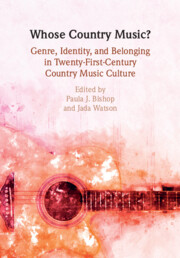Book contents
- Whose Country Music?
- Whose Country Music?
- Copyright page
- Contents
- Figures
- Tables
- Contributors
- “She went to Nashville to sing country music”
- Part I Industry
- Part II Codes of Conduct
- 5 Why Country Music Needs Latina Feminism
- 6 Pistol Annies
- 7 From Bros to Gentlemen
- 8 Cowboys on a Beach
- Part III Authenticity
- Part IV Boundary Work
- Bibliography
- Index
5 - Why Country Music Needs Latina Feminism
from Part II - Codes of Conduct
Published online by Cambridge University Press: 03 February 2023
- Whose Country Music?
- Whose Country Music?
- Copyright page
- Contents
- Figures
- Tables
- Contributors
- “She went to Nashville to sing country music”
- Part I Industry
- Part II Codes of Conduct
- 5 Why Country Music Needs Latina Feminism
- 6 Pistol Annies
- 7 From Bros to Gentlemen
- 8 Cowboys on a Beach
- Part III Authenticity
- Part IV Boundary Work
- Bibliography
- Index
Summary
The rise of Latina women in country music challenges long-standing narratives of country music’s racial and ethnic homogeneity. However, until recently, country music public discourse and academic scholarship alike have been slow to adopt an intersectional feminist framework that considers tools from Black and Latina feminisms as central to its analysis. This chapter focuses on Latina women’s place in country music and investigates the potential of Latina feminist frameworks in country music studies. Using what Mariana Ortega identifies as the “knowing, loving ignorance” of white feminism, this chapter shows how such a knowing loving ignorance in country music has enabled harmful lyrical tropes that sexualize, objectify, and exploit Latina women and women of color. This chapter argues that the Latina futures of country music require that country music practitioners and scholars center intersectional analyses as the genre continues to expand with new voices and epistemologies.
- Type
- Chapter
- Information
- Whose Country Music?Genre, Identity, and Belonging in Twenty-First-Century Country Music Culture, pp. 73 - 86Publisher: Cambridge University PressPrint publication year: 2022

